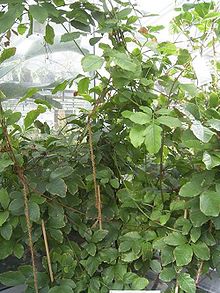Paullinia
| Paullinia | ||||||||||||
|---|---|---|---|---|---|---|---|---|---|---|---|---|

|
||||||||||||
| Systematics | ||||||||||||
|
||||||||||||
| Scientific name | ||||||||||||
| Paullinia | ||||||||||||
| L. |
Paullinia is a plant kind from the family of the soap tree plants (Sapindaceae). The approximately 195 species are almost all distributed only in the Neotropic .
distribution
Almost all species of the genus are native to tropical to subtropical America; only the species Paullinia pinnata is common in America and in tropical Africa.
description
The representatives of the genus Paullinia grow as woody evergreen climbing plants . The leaves are pinnate unpaired. Stipules are present.
They are monoecious separate-sex plants ( monoecious ). The traubige inflorescence also has two Klimmranken at the end of the spindle; they are in the leaf axils or kauliflor (stem-flowered) on the trunk and branches. The unisexual flowers are slightly zygomorphic . There are five unevenly shaped sepals and four petals . The eight stamens have hairless anthers . The ovary is three-chambered with one fruiting plant in each chamber. The stylus ends in three parts. The three-part capsule fruit releases the black seeds with a sarcotesta when torn open .

Systematics
The first official description is the listing of the genus in 1753 in the Species plantarum work by the Swedish scientist Carl von Linné . The German doctor Simon Pauli the Younger (1603–1680) is honored with the generic name . In the genus about 195 species are distinguished. Here is a selection of species:
- Paullinia acuminata Uittien : Suriname.
- Paullinia acutangula Pers.
- Paullinia alata (Ruiz & Pav.) G.Don : Panama, Trinidad and Tobago, western and northern South America, Brazil.
- Paullinia barbadensis Jacq.
- Paullinia bilobulata Radlk.
- Paullinia boliviana Radlk. ex Rusby
- Paullinia bracteosa Radlk.
- Paullinia brentberlinei Croat
- Paullinia caloptera Radlk.
- Paullinia clathrata Radlk.
- Paullinia clavigera Schltdl.
- Paullinia cuneata Radlk. : Brazil, Bolivia and Peru.
-
Guaraná ( Paullinia cupana Kunth ): Guiana, Venezuela, Brazil, Ecuador and Peru. With the variety:
- Paullinia cupana var. Sorbilis (Mart.) Ducke
- Paullinia cururu L .: Mexico, Guatemala, Honduras, Belize.
- Paullinia dasystachya Radlk.
- Paullinia elegans Cambess. : South America.
- Paullinia eriocarpa Triana & Planch. : Colombia, Ecuador, Peru, Brazil.
- Paullinia faginea Radlk.
- Paullinia fuscescens Kunth : Mexico to Venezuela and Trinidad.
- Paullinia grandifolia Benth. ex Radlk.
- Paullinia hemiptera, D.R. Simpson
- Paullinia hystrix Radlk.
- Paullinia imberbis Radlk.
- Paullinia ingifolia Rich. ex Juss.
- Paullinia leiocarpa Griseb. : Colombia, Guiana, Venezuela, Brazil and Trinidad.
- Paullinia macrophylla Cambess. : Colombia.
- Paullinia mariae J.F. Macbr.
- Paullinia neglecta Radlk.
- Paullinia obovata (Ruiz & Pav.) Pers.
- Paullinia pachycarpa Benth.
- Paullinia pendulifolia Rusby
- Paullinia pinnata L .: Tropical Africa, Madagascar, Mexico to Venezuela and Peru, Caribbean islands, Paraguay and Argentina.
- Paullinia platymisca Radlk.
- Paullinia quercifolia Rusby
- Paullinia rhizantha Poepp. & Endl.
- Paullinia ribesiicarpa Rusby
- Paullinia riparia Kunth
- Paullinia rugosa Benth. ex Radlk. : Panama, Colombia, Bolivia, Brazil.
- Paullinia sphaerocarpa Rich. ex Juss.
- Paullinia spicata Benth.
- Paullinia stellata Radlk.
- Paullinia subnuda Radlk.
- Paullinia tarapotensis Radlk.
- Paullinia tatei Rusby
- Paullinia thalictrifolia Juss. : Brazil.
- Paullinia tricornis Radlk. : Guiana, French Guiana and Suriname.
- Paullinia trigonia Vell. : Brazil.
- Paullinia turbacensis Kunth : Guatemala, Honduras, Nicaragua and Colombia.
- Paullinia yoco R.E. Schul . & Killip : Colombia, Ecuador and Peru.
Botanical history
Charles Plumier established the two genera Serjania and Cururu in 1703 and described three species each. Carl von Linné, however, combined both genres to form the new genus Paullina . The first descriptions of this generic name by Linnaeus are in the Hortus Cliffortianus , in which he lists all six species described by Plumier and refers to them as synonyms. The species described by Plumier can also be found in Species Plantarum of 1753; in this work they have the binary species names Paullinia seriana , Paullinia mexicana , Paullinia polyphylla (in Plumier Serjania ), Paullinia cururu , Paullinia curassavica and Paullinia pinnata (in Plumier Cururu ) and are supplemented by another species Paullinia asiatica .
use
The peeled and dried seeds of the guarana contain considerable amounts of caffeine and are used to make stimulating drinks. Poisonous components from Paullinia pinnata are used as arrow poison or as fish poison for fishing.
Web links
- Entry in the Flora of Zimbabwe (Engl.)
- Brief description at aluka.org (engl.)
- Species listing in the Bolivia Checklist
Individual evidence
- ^ Klaus Kubitzki : The Families and Genera of Vascular Plants. Vol. X, Springer, 2011, ISBN 978-3-642-14396-0 , p. 368.
- ↑ Carl von Linné: Species Plantarum . Volume 1, pp. 365f., Stockholm, 1753.
- ^ Carl von Linné: Critica Botanica . Leiden, 1737, p. 94
- ↑ See species listing in the Bolivia Checklist and species listing in GRIN Taxonomy for Plants .
- ↑ a b c d e f g h i j k l m n o p q Paullinia in the Germplasm Resources Information Network (GRIN), USDA , ARS , National Genetic Resources Program. National Germplasm Resources Laboratory, Beltsville, Maryland. Retrieved October 1, 2018.
- ^ Charles Plumier: Nova plantarum Americanarum genera . Paris, 1703, p. 34, plate 35
- ↑ Carl von Linné: Genera Plantarum . Leiden, 1742, p. 170
- ↑ Carl von Linné: Hortus Cliffortianus . Leiden, 1737, p. 151f.